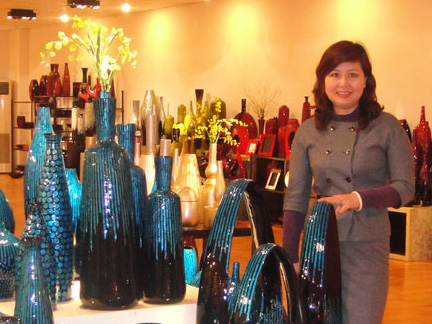

Reducing poverty among Vietnam’s craft producers

Reducing poverty among Vietnam’s craft producers
Hanoi, March 18 - Despite an almost 80 percent drop in its poverty rate over the last 15 years, Vietnam continues to struggle with significant inequalities and need, particularly in rural areas where the vast majority of the country’s poor reside.
Farming is often not sufficient to keep households above the national poverty line, and many farming families rely on producing handicrafts and the raw materials they require in order to survive.
Now a joint UN programme funded by the MDG-F is increasing income and employment opportunities for handicraft makers and the farmers who grow and collect raw materials for producing crafts. Some 4,800 households in the north of the country will benefit, including 1,400 families from disadvantaged ethnic minorities such as the Thai, Muong and H’mong. About 40% of these households live below the poverty line of 200,000 VND per capita/month (about 0.35 US$/day).
The UN programme’s approach is to develop better integrated, environmentally sustainable activities in five craft sectors: bamboo and rattan, sericulture and weaving, sea grass, lacquerware and handmade paper.
It focuses on strengthening the entrepreneurial skills of small and medium business owners, and teaching them better technologies and cleaner production methods. A team of foreign designers is helping the companies create new high-end sustainable product collections and linking them to more profitable markets. This, in turn, increases the income of producers and growers.
Duong Thi Thanh Thuy, whose company, Lacquerware, is one of 50 businesses participating in the programme, said her new skills will help improve the livelihoods of the poor rural households that tap lacquer trees to produce the lacquerware items she sells.
“Firstly, they will have more income for their life in addition to farming alone,” said Thuy (pictured above in her showroom). “Secondly, the art of lacquer production and the unique culture of Vietnam’s traditional villages will be introduced to the world through companies like ours.”
Lacquerworld sources natural lacquer resin from Phu Tho province, one of the UN programme’s target areas. Lacquer resin (or liquid) is harvested by tapping the lacquer trees, and is then used to coat the inner layers of the company’s colourful lacquerware products. Some 300 farmers in Phu Tho will receive support through the programme to plant, cultivate and harvest better and more productive lacquer trees.
Ms. Thuy recently took part in a workshop held by the UN Conference on Trade and Development (UNCTAD), one of the programme partners, to help entrepreneurs put ideas into action, grow their businesses and become more competitive. “This course helps to improve a lot of behaviors, including systems planning and monitoring, and taking calculated risks. Now I know how to make plans with a clear timeframe and how to anticipate and avoid risk in the future,” Thuy said.
The programme is also helping companies like Lacquerworld prepare for April’s “Lifestyle Vietnam”, one of the largest home decor and gifts fairs in Southeast Asia, by teaching business owners how best to display products, deal with customers and ensure proper follow-up to turn promising leads into actual business.
Vietnam has a long tradition of handmade crafts, and promoting a rapidly growing handicraft industry is part of the government’s plan to foster economic development and reduce unemployment across the country. The joint UN programme, “Green Production and Trade to Increase Income and Employment Opportunities for the Rural Poor,” aims to develop Vietnam’s private sector and contribute to the Millennium Development Goals of reducing poverty and hunger and promoting environmental sustainability. The programme will also contribute to gender equality in that it disproportionally benefits women, who are traditionally more engaged with craft production at the household and company level.
The joint programme is a collaboration between the Vietnamese government and five United Nations agencies: the International Trade Centre, the U.N. Industrial Development Organization, the Food and Agriculture Organization, the International Labour Organization and UNCTAD.